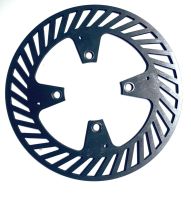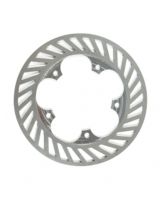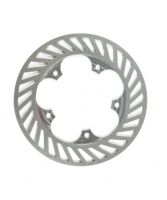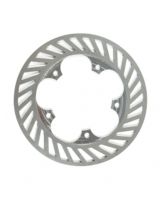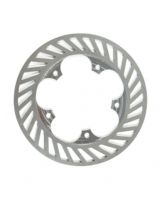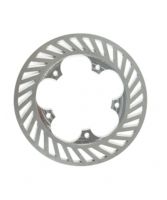Motorcycle brake discs - Brembo brake discs
There is no question that brakes are among the most important systems on a motorcycle. The entire braking system is made up of several individual components. All of them need to be regularly maintained and serviced. If the components are worn out or damaged, they need to be replaced. In our shop at TecBike you will find a wide range of products for all aspects of the motorcycle. Besides
t- Brembo motorcycle brake discs,
t- Brake discs from Moto-Master and
t- Accessories
you will find everything you need to turn your serial bike into your dream machine.
Attention biting! Motorcycle brakes from TecBike
In today's road traffic it is absolutely vital to brake really well. It is not only a question of driving skills. The technology must also meet these requirements at all times. The regular check of the brakes is therefore an absolute must for every motorcyclist. For maximum safety, it should not only be carried out by the TÜV, but at much shorter intervals.
When the specialist speaks of motorcycle brake discs, he is referring to the wheel-side part of the disc brake. To slow down the vehicle, the brake pads are pressed onto the disc and convert the kinetic energy into heat
Motorcycle brake discs consist of several parts: A carrier serves to connect the actual braking surface with the hub. In the past, manufacturers used to make the discs from grey cast iron. This material is extremely susceptible to rust. Therefore, modern variants consist almost exclusively of stainless steel.
If motorcycle brakes are subjected to intensive use, the pads and brake discs can quickly reach 500 °C or even higher temperatures. The racing sport makes special demands on man and material. Therefore carbon fiber discs have established themselves here. Only at temperatures of 200 to 300 degrees they reach a useful friction coefficient. They are therefore not suitable for rain races or in normal road traffic.
What are the holes in the brake disc for?
In the past, the holes were used to ensure faster brake response in rainy weather. In modern brakes they only improve cooling and reduce weight.
So-called wave brake discs not only have a chic look. Their roots lie in motocross. Compared to conventional discs they offer a better self-cleaning. They weigh less and also in terms of heat dissipation they are ahead.
Brake maintenance - what does it all involve?
If the brake is serviced, this includes
t- the replacement of outdated brake fluids,
t- the replacement of worn brake pads,
t- Check the brake disc and
t- if necessary, replacement of the brake disc.
Each manufacturer specifies a certain minimum thickness for its motorcycle brake discs. This must not be undercut. At the outermost edge of the brake disc a small protrusion is formed by the material removal. For this reason, the measurement should not be carried out with a caliper gauge, but with the so-called micrometer screw in order to avoid falsified measurement results.
Important: A brake disc must not only be replaced when the wear limit is not reached. If the brake discs heat up excessively under high braking forces, they wear extremely.
When you brake, the brake disc on the outer ring and the carrier star heats up to a different extent. This results in uneven thermal expansion. In the worst case, the brake disc warps. A classic example are pass descents. Very often there is a passenger and heavy luggage on board. If the curve hunt goes again in the direction of the valley, continuously pulled brakes let the temperatures rise extreme heights.
Clamping caliper pistons also frequentlydrive the temperatures of the discs upwards. In addition, there is the constant contact with the brake pads and wear and tear on them is exceptionally high. Especially brake discs with a large diameter and those that are rigidly suspended even warp.
Do not forget: Measure disc thickness
The brake disc becomes thinner and thinner as a result of braking. It is easy to determine whether it is still thick enough. Usually the minimum thickness specified by the manufacturer is noted on the disc. Usually this value is between 4 and 4.5 millimetres. To determine the brake disc thickness, we recommend a outside micrometer. Of course, professional accessories such as special brake disc measuring devices are also available. If the actual condition of your brake disc corresponds to the manufacturer's note, it is time to dispose of the old model.
Is the brake disc more similar to a record: are there deep grooves? If you can see the grooves or the ring-shaped grinding marks more than you can feel, everything is ok. If there is a need for action, you will get stuck with your fingernail when driving over them. As a first measure we recommend to replace the brake pads. If the pads are still in perfect condition, they can be carefully flattened. How does this work?
t- Remove the brake pads
t- Attach an 80 grain sandpaper either to a sanding block or a flat board and
t- carefully drag the pads nice and even and not down.
Motorcycle brake discs - when are they unusable?
Every now and then strange spots appear on the brake disc. They can be blue or brown. They are caused by very high temperatures and are called heat spots. If they cannot be "braked off", they can cause significant vibrations at the front of the brake and rub.
So-called friction coefficient jumps between disc and lining are considered to be the trigger. Changes in the microstructure occur in the heat spots. Please note: If the brake disc is warped, classic brake rubbing occurs. It should not be confused with the high frequency vibrations of the heat spots. The classic brake rubbing is caused by a lateral run-out of the brake disc. Not only does this cause uneven braking, it usually results in a pulsating brake lever. If heat spots occur, new brake pads can sometimes help. Here it is important to brake gently and with a lot of sensitivity during the first few kilometres.
Change motorcycle brake discs
The front or rear window is definitely broken? Then you will definitely need a replacement. Our range offers you a selection of high-quality accessories for all aspects of motorcycle braking. Now you are faced with the question of which disc model from which manufacturer you want to use. Sure, whatever goes, are the original parts. But they are connected with a corresponding price.
As already mentioned, Wave discs originate from the enduro and motocross sector. Their contour is reminiscent of a saw and is intended to "saw" the dirt out of the brake pads. On your road sweeper, on the other hand, these discs are a great visual gimmick. The outer contour has no influence on the braking behaviour here.
What do you need for a change?
t- Brake disc(s)
t- Matching brake pads. It is best to order them from us at the same time.
t- New screws: Nothing is more annoying to have to interrupt work because of worn-out screws.
t- Liquid screw lock. Exception: Microencapsulated screws. They have a greenish or blue rubber layer on the thread.
Before jacking up the bike, loosen all the screws. This way you avoid throwing the bike off the jacks, because the screws are usually extremely tight and you have to apply a lot of force.
Now you jack up the bike and take out the front wheel. To loosen or tighten the brake disc screws, you should only use perfect Torx or Allen nuts. Especially with Allen screws there is a risk that the screws will also round off.
After mounting the new discs, you mount the wheel again. Afterwards you jack up the bike completely. Now apply the front brake. Thereby you spring in as strongly as possible. This ensures a tension-free mounting of the front axle. Afterwards of course do not forget to tighten the axle clamp. Finally, check the brake fluid level in the reservoir. Once you have made sure that no grease marks have been left on the brake disc, the test drive can begin. Here you should take it slowly. It takes a few brake kilometres before the pads and the motorcycle brake discs bite really hard.
Attachments and accessories from TecBike
From a standard bike to a custom dream machine? Our extensive range offers you everything you need for the conversion, maintenance and care of your machine: from A for exhaust to components for the brake system to Z for accessories. Do you have questions about our products? Talk to us, we are very gladly there for you!
Motorcycle brake discs - Brembo brake discs There is no question that brakes are among the most important systems on a motorcycle. The entire braking system is made up of several individual...
read more » Close window Motorcycle brake discs - Brembo brake discs
There is no question that brakes are among the most important systems on a motorcycle. The entire braking system is made up of several individual components. All of them need to be regularly maintained and serviced. If the components are worn out or damaged, they need to be replaced. In our shop at TecBike you will find a wide range of products for all aspects of the motorcycle. Besides
t- Brembo motorcycle brake discs,
t- Brake discs from Moto-Master and
t- Accessories
you will find everything you need to turn your serial bike into your dream machine.
Attention biting! Motorcycle brakes from TecBike
In today's road traffic it is absolutely vital to brake really well. It is not only a question of driving skills. The technology must also meet these requirements at all times. The regular check of the brakes is therefore an absolute must for every motorcyclist. For maximum safety, it should not only be carried out by the TÜV, but at much shorter intervals.
When the specialist speaks of motorcycle brake discs, he is referring to the wheel-side part of the disc brake. To slow down the vehicle, the brake pads are pressed onto the disc and convert the kinetic energy into heat
Motorcycle brake discs consist of several parts: A carrier serves to connect the actual braking surface with the hub. In the past, manufacturers used to make the discs from grey cast iron. This material is extremely susceptible to rust. Therefore, modern variants consist almost exclusively of stainless steel.
If motorcycle brakes are subjected to intensive use, the pads and brake discs can quickly reach 500 °C or even higher temperatures. The racing sport makes special demands on man and material. Therefore carbon fiber discs have established themselves here. Only at temperatures of 200 to 300 degrees they reach a useful friction coefficient. They are therefore not suitable for rain races or in normal road traffic.
What are the holes in the brake disc for?
In the past, the holes were used to ensure faster brake response in rainy weather. In modern brakes they only improve cooling and reduce weight.
So-called wave brake discs not only have a chic look. Their roots lie in motocross. Compared to conventional discs they offer a better self-cleaning. They weigh less and also in terms of heat dissipation they are ahead.
Brake maintenance - what does it all involve?
If the brake is serviced, this includes
t- the replacement of outdated brake fluids,
t- the replacement of worn brake pads,
t- Check the brake disc and
t- if necessary, replacement of the brake disc.
Each manufacturer specifies a certain minimum thickness for its motorcycle brake discs. This must not be undercut. At the outermost edge of the brake disc a small protrusion is formed by the material removal. For this reason, the measurement should not be carried out with a caliper gauge, but with the so-called micrometer screw in order to avoid falsified measurement results.
Important: A brake disc must not only be replaced when the wear limit is not reached. If the brake discs heat up excessively under high braking forces, they wear extremely.
When you brake, the brake disc on the outer ring and the carrier star heats up to a different extent. This results in uneven thermal expansion. In the worst case, the brake disc warps. A classic example are pass descents. Very often there is a passenger and heavy luggage on board. If the curve hunt goes again in the direction of the valley, continuously pulled brakes let the temperatures rise extreme heights.
Clamping caliper pistons also frequentlydrive the temperatures of the discs upwards. In addition, there is the constant contact with the brake pads and wear and tear on them is exceptionally high. Especially brake discs with a large diameter and those that are rigidly suspended even warp.
Do not forget: Measure disc thickness
The brake disc becomes thinner and thinner as a result of braking. It is easy to determine whether it is still thick enough. Usually the minimum thickness specified by the manufacturer is noted on the disc. Usually this value is between 4 and 4.5 millimetres. To determine the brake disc thickness, we recommend a outside micrometer. Of course, professional accessories such as special brake disc measuring devices are also available. If the actual condition of your brake disc corresponds to the manufacturer's note, it is time to dispose of the old model.
Is the brake disc more similar to a record: are there deep grooves? If you can see the grooves or the ring-shaped grinding marks more than you can feel, everything is ok. If there is a need for action, you will get stuck with your fingernail when driving over them. As a first measure we recommend to replace the brake pads. If the pads are still in perfect condition, they can be carefully flattened. How does this work?
t- Remove the brake pads
t- Attach an 80 grain sandpaper either to a sanding block or a flat board and
t- carefully drag the pads nice and even and not down.
Motorcycle brake discs - when are they unusable?
Every now and then strange spots appear on the brake disc. They can be blue or brown. They are caused by very high temperatures and are called heat spots. If they cannot be "braked off", they can cause significant vibrations at the front of the brake and rub.
So-called friction coefficient jumps between disc and lining are considered to be the trigger. Changes in the microstructure occur in the heat spots. Please note: If the brake disc is warped, classic brake rubbing occurs. It should not be confused with the high frequency vibrations of the heat spots. The classic brake rubbing is caused by a lateral run-out of the brake disc. Not only does this cause uneven braking, it usually results in a pulsating brake lever. If heat spots occur, new brake pads can sometimes help. Here it is important to brake gently and with a lot of sensitivity during the first few kilometres.
Change motorcycle brake discs
The front or rear window is definitely broken? Then you will definitely need a replacement. Our range offers you a selection of high-quality accessories for all aspects of motorcycle braking. Now you are faced with the question of which disc model from which manufacturer you want to use. Sure, whatever goes, are the original parts. But they are connected with a corresponding price.
As already mentioned, Wave discs originate from the enduro and motocross sector. Their contour is reminiscent of a saw and is intended to "saw" the dirt out of the brake pads. On your road sweeper, on the other hand, these discs are a great visual gimmick. The outer contour has no influence on the braking behaviour here.
What do you need for a change?
t- Brake disc(s)
t- Matching brake pads. It is best to order them from us at the same time.
t- New screws: Nothing is more annoying to have to interrupt work because of worn-out screws.
t- Liquid screw lock. Exception: Microencapsulated screws. They have a greenish or blue rubber layer on the thread.
Before jacking up the bike, loosen all the screws. This way you avoid throwing the bike off the jacks, because the screws are usually extremely tight and you have to apply a lot of force.
Now you jack up the bike and take out the front wheel. To loosen or tighten the brake disc screws, you should only use perfect Torx or Allen nuts. Especially with Allen screws there is a risk that the screws will also round off.
After mounting the new discs, you mount the wheel again. Afterwards you jack up the bike completely. Now apply the front brake. Thereby you spring in as strongly as possible. This ensures a tension-free mounting of the front axle. Afterwards of course do not forget to tighten the axle clamp. Finally, check the brake fluid level in the reservoir. Once you have made sure that no grease marks have been left on the brake disc, the test drive can begin. Here you should take it slowly. It takes a few brake kilometres before the pads and the motorcycle brake discs bite really hard.
Attachments and accessories from TecBike
From a standard bike to a custom dream machine? Our extensive range offers you everything you need for the conversion, maintenance and care of your machine: from A for exhaust to components for the brake system to Z for accessories. Do you have questions about our products? Talk to us, we are very gladly there for you!
